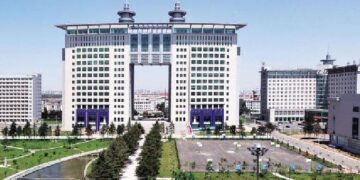In a landmark development for healthcare in Bangladesh, a meaningful deal has been reached between the government and chinese authorities to establish a state-of-the-art burn institute in Chittagong.The newly proposed facility, designed to accommodate 150 beds, aims to address the pressing needs of burn victims in the region, offering advanced medical care and rehabilitation services. This initiative comes amid rising concerns over burn injuries in Bangladesh,which disproportionally affect vulnerable populations. The agreement signifies a strengthening of bilateral relations and highlights China’s growing role in supporting infrastructural advancements in South Asia. As local officials look forward to the project’s implementation, the institute is expected to enhance the country’s healthcare capabilities and improve outcomes for burn patients, ultimately contributing to a safer and healthier community. This article delves into the key components of the deal, its anticipated impact on public health, and the broader implications for future collaborations between bangladesh and China.
Significance of the New Burn Institute in Chittagong’s Healthcare Landscape
The establishment of a state-of-the-art burn institute in Chittagong marks a pivotal moment in the region’s healthcare system, addressing a critical gap in specialized burn care.With a proposed capacity of 150 beds, this facility will considerably improve the quality of treatment accessible to patients suffering from burn injuries, which have been a persistent healthcare challenge in Bangladesh. The new institute aims to provide comprehensive services,including:
- Emergency Burn Care: Rapid response for severe burn cases.
- Rehabilitation Programs: Helping patients recover physically and emotionally.
- Research and Training: Fostering advancements in burn treatment and care.
Moreover, the collaboration with chinese partners symbolizes a growing trend of international cooperation in healthcare, leveraging expertise and resources to elevate local medical standards. The institute is expected to not only serve as a treatment center but also as a hub for knowlege and training, producing skilled professionals capable of addressing burn injuries effectively. The potential impact extends beyond immediate patient care, as it contributes to enhancing public health infrastructure and the overall resilience of healthcare services in Chittagong.

Collaborative Efforts: How the Deal with China Enhances Medical Infrastructure
The recent agreement to establish a 150-bed burn institute in Chittagong marks a significant milestone in enhancing the region’s medical infrastructure. This collaboration with China aims to leverage advanced technology and expertise, allowing for the integration of world-class facilities and practices in local healthcare. Such an initiative is expected to:
- Increase access to specialized care: Patients suffering from burn injuries will benefit immensely from prompt and comprehensive treatment.
- Train local healthcare professionals: The partnership paves the way for medical staff to gain invaluable experience through training programs conducted by Chinese experts.
- Boost research and development: A dedicated facility for burn treatment can foster innovation in medical practices and patient care.
This project exemplifies a strategic move towards holistic healthcare enhancement in Bangladesh. The positive implications extend not only to immediate medical services but also to the broader public health landscape. By enhancing local medical capabilities, the initiative can perhaps:
- Reduce overall healthcare costs: A specialized burn institute will alleviate the burden on general hospitals, streamlining patient care.
- Incorporate modern treatment methodologies: The adoption of sophisticated techniques from international partners will elevate the standard of care.
- Strengthen international relationships: This venture exemplifies the growing cooperation between Bangladesh and China, fostering goodwill and collaboration beyond healthcare.

Understanding the Funding and Investment Aspects of the Agreement
The recent agreement for a 150-bed burn institute in Chittagong signifies a pivotal investment aimed at enhancing healthcare infrastructure in Bangladesh. With funding primarily sourced from Chinese investment, the initiative is projected to not only bolster regional medical facilities but also enhance the country’s ability to manage burn injuries, which are prevalent due to various socio-economic factors. The partnership exemplifies a growing trend of international collaboration in health sector development, promoting shared resources and expertise. Key elements of the funding structure include:
- Government Contributions: A portion of the financing will come directly from the Bangladesh government,reflecting its commitment to improving healthcare access.
- Private Sector Involvement: Opportunities for private investors are being explored, creating a multifaceted funding ecosystem.
- Chinese Financial Institutions: These entities will play a crucial role in funding and possibly managing the project, ensuring adherence to international standards.
The financial model for this project is designed to ensure sustainability and efficiency. By aligning investment strategies with local healthcare demands, the institute aims to provide long-term value to the population. Below is a simplified outline of the financial distribution strategy:
| source of Funding | Percentage Contribution |
|---|---|
| Bangladesh Government | 30% |
| Chinese Investors | 50% |
| Private Sector Contributions | 20% |
This comprehensive approach not only facilitates the immediate construction and operational capabilities of the burn institute but also sets a precedent for future collaborative health initiatives within the region. By leveraging investment and expertise from multiple parties, the project underscores a commitment to elevating healthcare standards and addressing critical medical needs in Bangladesh.

Expected Challenges and Solutions for the Successful Operation of the Institute
As the establishment of the new 150-bed burn institute in Chittagong moves forward, several challenges may arise that could impact its successful operation. Key concerns include ensuring access to high-quality medical supplies and maintaining a steady supply of trained personnel adept in burn care. Moreover, it is indeed imperative to navigate the complexities of collaboration between local authorities and international partners, balancing regulatory compliance with effective operational strategies. Other potential issues may encompass funding sustainability, as ongoing operational costs could exceed initial estimates, thereby hindering long-term success.
To proactively address these challenges, a multifaceted approach will be required. some proposed solutions include:
- Establishing partnerships: Collaborate with local and international NGOs to secure medical supplies and expertise.
- Training programs: Develop continuous education and training initiatives for healthcare professionals to enhance burn care knowledge.
- Robust financial planning: Implement transparent budgeting and explore various funding sources, including government grants and private donations.
- Community engagement: Foster awareness and support within the local community to encourage utilization of the facilities and services offered.
additionally,a systematic evaluation process should be integrated into the operational plan. This could be visualized through a simple reporting structure:
| Evaluation Criteria | Frequency | Responsible Party |
|---|---|---|
| Patient Outcome Metrics | Quarterly | Medical Director |
| Resource Utilization Review | Bi-annual | Operations Manager |
| Financial Audit | Annual | finance Officer |
This comprehensive approach will not only mitigate risks but also foster a culture of growth and excellence within the institute, ultimately benefiting the patients who rely on its critical services.

Community Impact: addressing Burn Injuries in Vulnerable Populations
The establishment of a 150-bed burn institute in Chittagong,following a partnership with China,signals a transformative step towards improving healthcare for vulnerable communities. Burn injuries disproportionately affect marginalized groups due to limited access to medical resources and inadequate safety measures. The new facility will not only provide specialized care but also serves as a hub for education and prevention initiatives.This investment is expected to address critical issues such as:
- Enhanced treatment options for burn patients.
- Training programs for local healthcare professionals.
- community outreach initiatives aimed at raising awareness about fire safety.
- Collaboration with NGOs to assist in rehabilitation efforts.
Additionally, the institute’s implementation aligns with broader public health goals, aiming to create a more resilient healthcare infrastructure. Partnerships with local organizations will facilitate the integration of culturally sensitive practices and ensure that the voices of affected communities are heard. Within the facility, a dedicated team will focus on not only acute care but also long-term psychological support for survivors. The importance of mental health cannot be overstated,especially when considering the emotional trauma associated with severe burn injuries. As we look to the future, the commitment to providing comprehensive care will foster a sense of hope and recovery among the most at-risk populations.
Future Prospects: Expanding Healthcare Partnerships Beyond the Burn Institute
The recent agreement to establish a 150-bed burn institute in Chittagong marks a significant milestone in healthcare collaboration, notably with China stepping up as a key partner. However, the potential for expanding these healthcare partnerships extends far beyond the scope of burn treatment. By leveraging our newly established connections, stakeholders can explore opportunities to enhance medical infrastructure, training, and resources in other critical areas. This initiative sets a groundwork not only for specialized burn care but also for integrated regional healthcare that can effectively address a multitude of public health challenges.
Future prospects could include partnerships aimed at:
- Expansion of Specialized Units: Establishing additional facilities for trauma care, rehabilitation, and plastic surgery.
- Research and Development: Joint initiatives focusing on innovative treatment methods and technologies in burn care and beyond.
- Medical Training programs: Collaborating with educational institutions to provide training for healthcare professionals in advanced burn care techniques.
- Community Health Initiatives: Programs designed to raise awareness about burn prevention and treatment, benefiting underserved populations.
| Partnership Focus | Potential Benefits |
|---|---|
| Trauma Care | Improved emergency response and recovery options for critical cases. |
| Innovative Research | Advancements in treatment methodologies and patient outcomes. |
| Training Programs | Enhanced skills and knowledge for healthcare workers in the region. |
| Community Health | Reduction in burn incidents and increased public awareness. |
In summary
the recent agreement between bangladesh and China to establish a 150-bed burn institute in Chittagong marks a significant advancement in the nation’s healthcare infrastructure.This initiative not only aims to provide much-needed specialized care for burn victims but also reflects a broader commitment to improving medical services across the region. the collaboration highlights the potential for international partnerships to address critical health challenges, contributing to better outcomes for patients and enhancing the capabilities of local medical professionals. As the project progresses, stakeholders will be keenly observing its impact on burn treatment in Bangladesh and the broader implications for healthcare development in South Asia. The establishment of this institute symbolizes hope for many and underscores the importance of sustained investment in public health initiatives.














